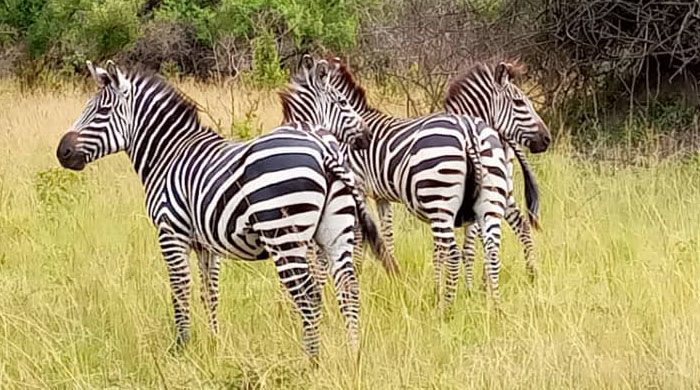SEMULIKI NATIONAL PARK

Travel
ADVENTURE

Wildlife & Birdwatching
BEACHES

National Parks & Reserves
CAMPING

Honeymoon & Family
FRIENDLY

Cultural & Community
ADVENTURE

Hiking & Explorations
UNIQUE
SEMULIKI NATIONAL PARK
Location
Semuliki National Park is found in Bwamba County, a remote part of Bundibugyo District in Western Uganda.
Semuliki National Park lies on the border of Uganda and the Democratic Republic of Congo. The Rwenzori Mountains are to the south-east of the park, while Lake Albert is to the north.
Semuliki National Park is about 290km (about 6hrs drive) from Kampala and visitors can get there by driving via Mubende and Fort Portal. Or if you are taking the Kampala-Masaka-Mbarara-Kasese route, the drive can take 7-8hrs (465km).
You can also choose to fly from Entebbe International Airport or Kajjansi Airstrip into Kasese and then drive about 2hrs to Semuliki National Park (both scheduled and private flights are possible). The flight takes about 2 hours.

About the park
Semuliki Forest Reserve is popularly known as the true birders’ haven. It was created in 1932 and later upgraded to national park status in 1993. The park lies within the Albertine Rift and is located on a flat to gently undulating landform that ranges from 670 to 760 m (2,200 to 2,490 ft) above sea level. It encompasses 219 km2 of East Africa’s only lowland tropical rainforest, hosting 441 recorded bird species and 53 mammals. Therefore, it is one of the richest areas of floral and faunal biodiversity in Africa.
Semuliki National Park sprawls across the floor of the Semuliki Valley on the remote, western side of the Rwenzori. The park is dominated by the easternmost extension of the great Ituri Forest of the Congo Basin. This is one of Africa’s most ancient and bio-diverse forests; one of the few to survive the last ice age, 12-18,000 years ago. The reserve is a classic geographic crossroads – tropical rainforest meets grassy savannah, wetlands spill over into Lake Albert and the flat plains are punctuated by deep river valleys. This unique confluence is reflected in the diversity of wildlife, too. The Central African forest elephant lives alongside the savannah species – lions, leopards and antelope.
While Semuliki’s species have been accumulating for over 25,000 years, the park contains evidence of even older processes. Hot springs like the famous Sempaya Hot springs bubble up from the depths of the earth to demonstrate the powerful subterranean forces that have been shaping the rift valley during the last 14 million years.
Hippos and crocodiles are common along the Semuliki River. More than 300 butterfly species have been identified, including 46 species of forest swallowtail, together with 235 moth species. Over 435 bird species have been recorded in Semuliki National Park. The bird checklist includes 35 Guinea-congo forest biome species, Congo Serpent Eagle, Spot-breasted Ibis, Haartlaub’s Duck, Chestnut-flamed Goshawk. In addition, there are 11 recorded species unique to Semliki, including the pygmy antelope, two types of flying squirrel and six types of bats. Visitors to the park can track elusive chimpanzees in the forest, game drive on the savannahs and cruise Lake Albert in search of the bizarre-looking Shoebill.
Activities
Birding
Semuliki National Park has a rich diversity of bird species and visitors to this park are mainly birding enthusiasts. Regardless of its remoteness, it is one of the most spectacular Important Bird Areas (IBAs) and is home to over 450 bird species (45% of Uganda’s total bird species) including over 216 (66%) typical forest bird species in Uganda, 9 incredible hornbill species, 50 species of birds that are not found anywhere else in East Africa but are endemic to this park such as Congo Serpent Eagle and over 133 bird species out of the total 144 Guinea-Congo Forest bird species are found in Semliki National Park. With these interesting bird species, Semuliki National Park is a bird watcher’s Paradise and place to be for a memorable bird watching experience. This park is characterized by different vegetation types such as riverines, grasslands and forests that offer shelter to several of these bird species.
Some of the interesting bird species visitors can look out for include Blue-headed Crested Flycatcher, Dwarf Honeyguide, Grauer’s Cuckoo-shrike, Blue-billed Malimbe, Ross’s Turaco, White-crested Hornbill, Grant’s Bluebill, Black-dwarf Hornbill, Yellow-throated Nicator, Purple-breasted Sunbird, Lyre-tailed Honeyguide, Swamp Palm Bulbul, Red-eyed Puffback, Chestnut-bellied Helmet Shrike, White-thighed Hornbill, Fire-crested Alethe, Long-tailed Hawk, Great Blue Turaco, Red-billed Dwarf Hornbill, White-bellied Kingfisher, Xavier Greenbul, Rufous-sided Broadbill, Green-tailed Bristlebill, African Piculet, Lemon-bellied Crombec, Capuchin Babbler, Forbe’s Plover, Zenker’s Honeyguide, Piping Hornbill, Pale-fronted Negrofinch, Red-bellied Malimbe, Eastern-bearded Greenbul, Gabon Woodpecker, Crested Malimbe, Nkulengu Rail, Northern Bearded Scrub Robin, Chestnut-breasted Negrofinch, Maxwell’s Black Weaver, Leaf-love, Spot-breasted Ibis, Red-rumped Tinkerbird, Yellow-throated Cuckoo, White-tailed Hornbill, Dusky Nightjar, Chestnut Owlet, Bates Nightjar, Sassi’s Olive Greenbul, Grant’s Bluebill, Black-throated Coucal, Black-casqued Wattled Hornbill, Spotted Honeyguide, Orange-cheeked Waxbill, Western Bronze-naped Pigeon, Red-thighed Sparrow Hawk, White-throated Blue Swallow, Eastern-bearded Greenbul, Fiery- breasted Bush-shrike, and Hartlaub’s Duck.
Visitors need to carry their cameras, binoculars and drinking water for a memorable bird watching experience. The best time for bird watching in this park is during the rainy season (March to May and October to November) because this is prime breeding season with many bird species easily sighted and also the perfect time to see the migratory bird species.
Nature walks
Nature walks and hiking in Semuliki National Park offer a chance to get up close to the mammals, birds and butterfly species in this park. There are 3 trails i.e. the Kirumia Trail (13km) which runs through the heart of the forest to the Semuliki River. It takes about 8 hours and is perfect for birders. There are multiple watering holes en route. Another one is Red Monkey Track (11km) – this one follows the eastern border of the park and visitors can sight the De-braza’s Monkey. It also continues up to the Semuliki River. The third one is the Sempaya Nature Trail (8km) – this one runs from the male hot springs (Bitende) and the female hot springs (Nyasimbi). A good number of primates can be sighted on this walk.
Visiting Sempaya Hot springs
These hot springs have attracted many visitors to Semuliki National Park because of the rate at which they boil. It is truly a sight to behold. As you approach the ever-boiling Sempaya Hot springs, a strange pungent smell of hydrogen sulfur hits your nose. The most exciting activity here is the cooking of food items because the temperatures are very high. Food like matooke, Irish potatoes and cassava can be prepared. Most visitors to this place prefer cooking eggs and when they are ready, they are as hot as those cooked using traditional cooking methods. The hot springs are believed to have healing powers and many of the locals flock these hot springs in search of the secret gods who will administer healing upon them.
Game drives
Day and night game drives take place in the open savannah plains of Semuliki National Park. This park is home to 53 different mammal species about 27 of which are larger mammals while 11 species are endemic to this park. The endemics include flying squirrel, pygmy antelopes, and fanged deer. Some of the usual suspects include Uganda Kob, buffalo, elephant, waterbuck, crocodile, and wart hog. Night game drives can yield leopard, white-tailed mongoose among others. Game drives are best conducted in a comfortable 4×4 safari vehicle with a pop-up roof. You also need a strong flash light for better night game drive sightings.
Chimpanzee trekking
Chimpanzee trekking is one of the activities that visitors can participate in during their safari to Semuliki National Park. It is a bit of a challenge because of the landscape which hinders the chimpanzees from moving over sharp cliffs. Therefore, trekkers hike through swamps, thickets and shrubs and more in order to track down the primates. The trekking takes place in the morning which takes about 1-3 hours depending on how the chimpanzees are moving. In addition to chimpanzees, trekkers can expect to see Black and White Colobus Monkey, Baboon, de Brazza Monkey, Dent’s Mona Monkey, Red-tailed Monkey, Grey-cheeked Mangabey, Central African Red Colobus Monkey among others.
Itinerary ideas
3 days Semuliki National Park
Day 1 – Drive to Semuliki National Park, evening game drive, overnight
Day 2 – Boat trip on Lake Albert, visit Sempaya Hot springs, game and birding drive, overnight,
Day 3 – Drive back to Kampala
4 days Semuliki National Park
Day 1 – Drive to Semuliki National Park, overnight
Day 2 – Chimpanzee tracking, visit Sempaya Hot springs, night game drive, overnight
Day 3 – Boat trip on Lake Albert, game drive, community visit, overnight
Day 4 – Drive back to Kampala.
Accommodation
Upmarket: Semuliki Safari Lodge
Midrange: Ntoroko Game Lodge, Nyati Game Lodge, Mountains of the Moon Hotel
Budget: Kirimia Guesthouse, UWA Bandas and Campsite

MONTHLY NEWS UPDATES
Get latest news about Uganda’s weather focus, best times to travel, trending news, best travel offers, top destinations for the season, trending news and safe areas to visit
